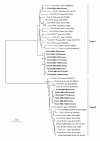Prevalence of Korean cats with natural feline coronavirus infections
- PMID: 21951835
- PMCID: PMC3219666
- DOI: 10.1186/1743-422X-8-455
Prevalence of Korean cats with natural feline coronavirus infections
Abstract
Background: Feline coronavirus is comprised of two pathogenic biotypes consisting of feline infectious peritonitis virus (FIPV) and feline enteric coronavirus (FECV), which are both divided into two serotypes. To examine the prevalence of Korean cats infected with feline coronavirus (FCoV) type I and II, fecal samples were obtained from 212 cats (107 pet and 105 feral) in 2009.
Results: Fourteen cats were FCoV-positive, including infections with type I FCoV (n = 8), type II FCoV (n = 4), and types I and II co-infection (n = 2). Low seroprevalences (13.7%, 29/212) of FCoV were identified in chronically ill cats (19.3%, 16/83) and healthy cats (10.1%, 13/129).
Conclusions: Although the prevalence of FCoV infection was not high in comparison to other countries, there was a higher prevalence of type I FCoV in Korean felines. The prevalence of FCoV antigen and antibody in Korean cats are expected to gradually increase due to the rising numbers of stray and companion cats.
Figures


References
-
- Pedersen NC. An overview of feline enteric coronavirus and infectious peritonitis virus infections. Feline Pract. 1987;23:7–22.
-
- Pedersen NC, Black JW, Boyle JF, Evermann JF, McKeirnan AJ, Ott RL. Pathogenic differences between various feline coronavirus isolates. Adv Exp Med Biol. 1984;173:365–380. - PubMed
MeSH terms
Substances
Associated data
- Actions
- Actions
- Actions
- Actions
- Actions
- Actions
- Actions
- Actions
- Actions
- Actions
- Actions
- Actions
- Actions
- Actions
- Actions
- Actions
LinkOut - more resources
Full Text Sources
Miscellaneous

